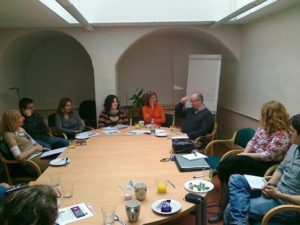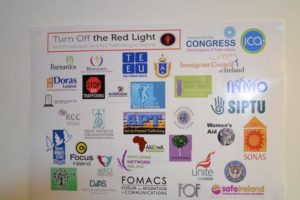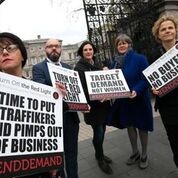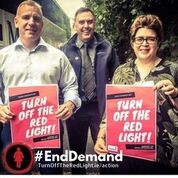Building a broad alliance:
A broad alliance is a core part of the campaign’s strategy, ensuring wide support for an issue that is not visible to all, and ensures it stays on the political agenda, until the legal change is realised. From the outset, building a broad alliance was a key strategy of the Campaign. Having analysed campaigns and change efforts in other countries, it was clear that a range of interests were vital in successful legislative change. The issue of prostitution and sex trafficking was considered a ‘minority’ issue in political terms, and in the public sphere, so the campaign wanted to recruit broad base support for the change it was advocating. From the outset, the campaign had a very clear ask. The problem was defined clearly for members, relevant to their interest, with a key solution, based on international expertise and success. It focuses all activities towards this main aim and the clarity of the objective of the campaign.
At the initial stages, founder members strategised over who had a stake in this change and how they might be engaged. The campaign looked to recruited those with the formal power to make or block a decision, those who would be affected by the decision, and those with relevant expertise and information. Once the campaign identified the relevant stakeholders, it then agreed how to involve them and prioritise those for a coalition and collaborative process. The campaign recruited actively into the campaign membership, first to the core strategic group, then to the advisory committee and then those who would be champions and/or endorsers of the campaign. A strategy and mechanism to communicate with all those involved, at varying levels, was devised, with regular feedback on the campaign’s process.

A clear process was designed, with a number of groups recruited as the core organising structure inclusive of a coordinating body, with responsibility for communications, mobilisation and strategic oversight. In addition, a larger advisory committee was recruited, to sign up to the clear aim of the campaign and to support its work, advising and inputting at key moments. The core group met regularly to progress the work, and the advisory committee met approximately four times a year, often with expert input on elements of the campaign.
The process was designed to ensure that the campaign structure has the capacity to be adaptive and responsive to changes and opportunities in the external environment. The structure was also designed that the core group could recognise key strategic moments and opportunities. We recruited representatives to the campaign that had the mandate to make decisions to ensure flexibility and responsiveness to the external environment. This also was an indication of the commitment of the participating organisations.
Members of the campaign were resourced to participate at varying and appropriate levels. Training and opportunity for discussion, collectively and individually, was an ongoing strategy to ensure engagement and continued participation. In terms of media liaison, template local media releases, opinion pieces were offered for all national activities. A social media strategy was implemented to support all activities, with an action page to encourage individual participation. Local events were encouraged and supported. Champions and endorsers nationally and locally were recruited to support member activities. Likewise, key members communicated activities, challenges and opportunities back to the coordinating body, informing on- going development of the campaign strategy and its implementation.
The campaign had 72 organisations representing every sector of Irish society, collaborating with the aim of securing the introduction of sex buyer laws and the de-criminalisation of all those exploited in prostitution. There was a geographical spread of member org anisations to encourage engagement and support of local political representatives and local media interest. Those exploited by the sex trade and, to be most affected by the legislative change, were central to the campaign through participation of survivors and frontline services. Maintaining a coalition of passionate, engaged groups was key to the campaign, to expand the reach and increases media attention, while ensuring that the goals of the campaign were maintained by core stakeholders with direct experience in the issues. Partners’ experience in the area of trafficking and prostitution were extremely varied, but reasons for participation were consistently based on gender equality and human rights concerns. This singular unifying vision allowed a common footing on which the group could base all messaging and actions.
anisations to encourage engagement and support of local political representatives and local media interest. Those exploited by the sex trade and, to be most affected by the legislative change, were central to the campaign through participation of survivors and frontline services. Maintaining a coalition of passionate, engaged groups was key to the campaign, to expand the reach and increases media attention, while ensuring that the goals of the campaign were maintained by core stakeholders with direct experience in the issues. Partners’ experience in the area of trafficking and prostitution were extremely varied, but reasons for participation were consistently based on gender equality and human rights concerns. This singular unifying vision allowed a common footing on which the group could base all messaging and actions.
Utilising the passion of all partners for the goals within the existing structures of their organisations meant that the campaign could be at its most effective. It was important that the strengths and experience of the partners was drawn upon: knowing who could drive change and action in media and political spheres as well as grassroots camp aigning meant that groups could employ their own skill sets and enjoy ownership of definable achievements within the coalition.
aigning meant that groups could employ their own skill sets and enjoy ownership of definable achievements within the coalition.
To ensure a high level of expertise and insight, informing strategies and activities, academic involvement was prioritised to ensure quality to our evidence based arguments and positions. The campaign recognised the need to address the core concepts and arguments in relation to prostitution so as to build a broad alliance which would support the introduction of a law criminalising the purchase of sex. International and Irish research and the experience, knowledge and testimony from frontline services and survivors were gathered in order to provide a strong evidence base from which the different sectors could present their position and ensure buy in by their members/sector.
It was recognised that the Trade Union movement was critical to the campaign in advocating the harm of prostitution and negating the promotion of prostitution as a as a legitimate form of work that can be made safe under the right  working conditions. Trade Unions highlighted that prostitution is an exploitative market organised by pimps and not a work sector which the Trade Union movement should be supporting and unionising. They presented extensive research demonstrating the failure of legalisation in other jurisdictions to protect the welfare and safety of women. The Medical and Health Unions and Associations provided evidence of the harmful impacts of prostitution on women’s mental, physical, sexual and reproductive health. They advocated for the need to continue to provide sexual health services to women in prostitution, alongside exit strategies.
working conditions. Trade Unions highlighted that prostitution is an exploitative market organised by pimps and not a work sector which the Trade Union movement should be supporting and unionising. They presented extensive research demonstrating the failure of legalisation in other jurisdictions to protect the welfare and safety of women. The Medical and Health Unions and Associations provided evidence of the harmful impacts of prostitution on women’s mental, physical, sexual and reproductive health. They advocated for the need to continue to provide sexual health services to women in prostitution, alongside exit strategies.
Children’s organisations highlighted the evidence on young age of entry and the compromised and limited nature of the concept of choice as framing girls’ and women’s entry into prostitution. They bought to the debate the numerous studies indicating a range of vulnerability factors which define entry into and entrapment within the sex industry including poverty, child maltreatment, homelessness, prior sexual abuse and family dislocation which make girls vulnerable to the tactics of pimps, recruiters and traffickers: tactics which include deception, seduction, control, grooming, threats, coercion, violence and entrapment.
Women’s organisations focused on how prostitution undermines gender equality and enshrines men’s right to have sexual access to women’s bodies. They highlighted how the sex industry increases the commodification and objectification of women and how harmful this is for all. Gender based violence organisations highlighted the intrinsic violence, especially sexual violence, that underpins prostitution. They communicated their experience of working with women in abusive relationships whose ‘partners are in fact their pimps’. Rape crisis centres focused on the sexual violence inherent in prostitution and the importance of promoting the concept of mutual sexual consent that is undermined within prostitution sex. Men’s organisations joined the coalition to communicate the message to men and boys that it is not ok to buy someone for sex and to promote the positive message of mutual negotiated sex for young women and men.
Migrants’ rights organisations were involved to highlight the changing profile in prostitution in Ireland, with the predominance of young migrant women in the Irish sex trade (87%-97%) reflecting the figures in other destination countries in Europe (80%-90%). They educated on global issues related to sex trafficking demonstrating that impoverished regions of the world are the areas of recruitment and trafficking by the sex trade.
The campaign shared its vision to inspire people to participate. Its internal communication process focused on results, key milestones and the celebration of accomplishments. The process and campaign was designed to encourage maximum, but appropriate involvement, strategising and reviewing regularly the level, and timing, of collaboration with various partners/stakeholders, at various stages.
Internal communications for the campaign were consistently cooperative rather than top-down, which allowed greater involvement and participation of the partners. By inviting ideas that adhered to the goals of the campaign and recreating those that were successful, the campaigned had a shared understanding of the types of actions most useful for certain contexts. Through trial and error, there was a strong knowledge base throughout the partnership of the types of events that worked on a local level and those that worked in the political space. Involving partners in both levels of campaigning, encouraged participation.
 Asking partners with varying levels of commitment and prioritisation to maintain involvement and to give their time to the campaign was a difficult balance. It was very important that partners felt like there was progress, but equally the campaign could not constantly be ‘on the verge of a win’ without leading to mass fatigue. Breaking the overall campaign into achievable steps was essential to keeping partners engaged. Not every partner’s unique skills fitted with each goal, which allowed for a relay of sorts and for individuals to recharge between rallies.
Asking partners with varying levels of commitment and prioritisation to maintain involvement and to give their time to the campaign was a difficult balance. It was very important that partners felt like there was progress, but equally the campaign could not constantly be ‘on the verge of a win’ without leading to mass fatigue. Breaking the overall campaign into achievable steps was essential to keeping partners engaged. Not every partner’s unique skills fitted with each goal, which allowed for a relay of sorts and for individuals to recharge between rallies.
Challenges arose with rotating committees or staff turnover, and at times it was be necessary to step back and re-engage certain groups. This was a natural part of the campaign’s lifetime, and while it was resource-intensive, it is also provided an opportunity to hone messaging and invite new ideas.
Once partners are aware of the importance of their individual roles there is a great opportunity to work together, sharing information and learning along the way towards our goals. The first partners to join Turn off the Red Light are stalwarts of the movement and remain some of the strongest voices for the cause. Newer additions consistently re-energise the group and bring fresh ideas and approaches to the table. These elements combined to maintain mobilisation and have kept the campaign moving towards enactment of legislation curbing demand and bringing justice for the women and girls who were always at the centre of the cause.
| Statement by Catríona Gratham – Coordinator of TORL
The Turn Off the Red Light campaign has developed interest and support from the general public, making the campaign not just a local issue but also a national one. Maintaining a coalition of passionate, engaged groups has been key to these efforts: this expands our reach and increases media attention, while ensuring that the goals of the campaign are maintained by core stakeholders with direct experience in the issues. A coalition as broad as Turn Off the Red Light, with membership spanning everything from front-line service providers to farming groups, provides a plethora of both challenges and opportunities. Partners’ experience in the area of trafficking and prostitution are extremely varied, but reasons for participation is consistently based on gender or human rights concerns. This singular unifying vision allows a common footing on which the group can base all messaging and actions. When the campaign membership was growing beyond front-line service providers working in the area, shared messaging became essential. Working with media experts, and using the knowledge base of the established core group, all partners were invited to contribute to what the central messaging of the campaign would be. This led to a small number of key points and asks, stemming from the singular goal of legislative change, which could be used by any partner no matter their background or area of work. Despite varying commitment, this still allowed for a consistent approach across all platforms. This not only enables partners who are unfamiliar with the subject matter to engage, but also ensures that the public hear consistent terminology and calls to action from all relevant groups. Internal communications for the campaign have been consistently cooperative rather than top-down, which allows greater involvement and participation of the partners. By inviting ideas that adhere to the goals of the campaign and recreating those that are successful, we have a shared learning of the types of actions most useful for certain contexts. Through trial and error, there is a strong knowledge base throughout the partnership of the types of events that work on a local level and those that work in the political space. Involving partners in both levels of campaigning encourages participation. Asking partners with varying levels of commitment and prioritisation to maintain involvement and to give their time to the campaign is a difficult balance. It is very important that partners feel like there is progress, but equally the campaign cannot constantly be ‘on the verge of a win’ without leading to mass fatigue. Breaking the overall campaign into achievable steps is essential to keeping partners engaged. Not every partner’s unique skills will fit with each goal, which allows for a relay of sorts and for individuals to recharge between rallies. Utilising the passion of all partners for the goals within the existing structures of their organisations means that the campaign can be at its most effective. It is important to play to the experience of the partners: knowing who can drive change and action in media and political spheres as well as grassroots campaigning means that groups can employ their own skill sets and enjoy ownership of definable achievements within the coalition. Challenges will arise with rotating committees or staff turnover, and at times it will be necessary to step back and re-engage certain groups. This is a natural part of the campaign’s lifetime, and while it is resource-intensive and can be tiring, it is also an opportunity to hone messaging and invite new ideas. The cyclical nature of the campaign is a key strength for its growth and success. Personal stories from the core partners generate media interest, which grows public involvement. This gives the campaign credibility and increases awareness of our goals with stakeholders, leading to increased membership. This feeds our knowledge-base, leading in turn to more media attention. Each point in this cycle is an opportunity for political engagement: media content, public engagement and partner contacts all lead to awareness on the part of politicians at a local level. The broad variety of member organisations in the campaign allows for the opportunity to engage new political champions, and is always maintained as the end sight of all campaign actions. Once partners are aware of the importance of their individual roles there is a great opportunity to work together, sharing information and learning along the way towards our goals. The first partners to join Turn Off the Red Light are stalwarts of the movement and remain some of the strongest voices for the cause. While they have allowed for consistency in approach and can act as a guiding voice, newer additions consistently re-energise the group and bring fresh ideas and approaches to the table. These elements combine to maintain mobilisation and have kept the campaign moving towards enactment of legislation curbing demand and bringing justice for the women and girls who are always at the centre of the cause. |
Coalition building
Jerry O’Connor –
Former political strategist to the campaignx
x
Dr Monica O’Connor
x
x
x
x
x
Rachel Moran –
Survivor activist
x
Sr Stan Kennedy –
Founder of the Immigrant Council of Ireland
Footnotes
1Kelleher Associates, O’Connor M., and Pillinger, J. (2009). Globalisation, sex trafficking and prostitution: The experiences of migrant women in Ireland. Dublin: Immigrant Council of Ireland.